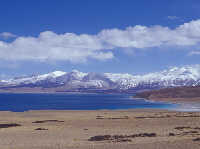|
Mampang Yumco Lake
( 2005-10-14 )
 Best time to go: From July to August Best time to go: From July to August
Mampang Yumco Lake is located about 20 kilometers southeast of Kangrinboqe, the main peak of the Kangdese Mountains, at an elevation of 4,588 meters. It covers some 400 square kilometers and has a maximum depth of 70 meters. The lake is recognized as a holy site by various religions and also thought to be the highest freshwater lake in the world.
Mampang Yumco in Tibetan means the "eternal and invinciblejadelake," and was named to mark the victory ofBuddhismover the local Bon Religion in the 11th century. It is taken as "the king of holy lakes" with fame as great as the holy mountain of Kangrinboqe.
The lake derives most of its water from melting snow in the Kangdese Mountains.Offset by blue skies and white clouds, it is as beautiful as a fairyland, transparent, tranquil and boundless. Blue waves roll softly across the lake, and distant mountains are seen indistinctly around it.
It cannot be regarded as the best of the lakes on the plateau in terms of its size, depth, altitude or beauty. Only its mystery and name make it a holy lake, residents say, and many religious records and legends record its origins.
According to Tibetan Buddhism, the GuangcaiDragonKing Palace lies at the bottom of the lake. In front of the palace is Tsampo Zhaxi, which is a holy tree sending out light as the source of happiness on the earth.
Indian legend claims the lake to be a place where Siva and his wife Goddess Woma, daughter of the Himalayas, bathed.
In Buddhist scriptures, the lake named the "mother of the rivers in the world" refers to the holy lake, Mampang Yumco, which enjoys a reputation equal to the holy mountain of Kangrinboqe. Xuan Zang (600-664), an eminent monk who lived during theTang Dynasty(618-907). He described the Mampang Yumco Lake in his book Records of Western Travels as "a jade pond in west."
There are eight monasteries surrounding the lake. Gyiwu Monastery and Curgu Monastery are the best known of them. The area surrounding Curgu Monastery is respected as a holy and pure bathing site.
|

